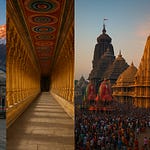Eastern India, with its rich cultural and spiritual heritage, boasts some of the most revered temples and religious landmarks in the country. These sacred spaces, with their intricate architecture, profound history, and enduring significance, embody the essence of India's spiritual diversity. This article delves into the histories, significance, and architectural marvels of key temples in the region.
1. Jagannath Temple, Puri (Odisha)
History: Built in the 12th century by King Anantavarman Chodaganga Deva, the Jagannath Temple is one of the Char Dham pilgrimages in Hinduism.
Significance: Dedicated to Lord Jagannath (a form of Vishnu), this temple is famous for its annual Rath Yatra (Chariot Festival), where the deities are paraded on massive chariots.
Architecture: The temple features Kalinga architectural style with a towering spire (Shikhar) that dominates Puri's skyline. The temple complex also houses smaller shrines and a massive kitchen that feeds thousands daily.
Unique Aspects: The non-decaying wooden idols of Jagannath, Balabhadra, and Subhadra are replaced every 12-19 years in a sacred ritual called Navakalevara.
2. Konark Sun Temple, Konark (Odisha)
History: Built in the 13th century by King Narasimhadeva I of the Eastern Ganga dynasty, the Sun Temple is a UNESCO World Heritage Site.
Significance: The temple is dedicated to Surya, the Sun God, symbolizing the passage of time and celestial rhythms.
Architecture: Shaped like a massive chariot with 24 intricately carved wheels, the temple showcases exquisite stone carvings depicting scenes from daily life, mythology, and flora and fauna.
Unique Aspects: Known as the "Black Pagoda," it was a navigational landmark for sailors. Despite being partially in ruins, its grandeur continues to inspire awe.
3. Dakshineswar Kali Temple, Kolkata (West Bengal)
History: Established in 1855 by Rani Rashmoni, a philanthropist and devotee of Goddess Kali.
Significance: The temple is associated with Sri Ramakrishna Paramahamsa, a revered mystic and saint who served as its priest.
Architecture: The temple complex includes nine spired structures (Nava-ratna style), a bathing ghat on the Hooghly River, and 12 smaller shrines dedicated to Shiva.
Unique Aspects: It remains a spiritual hub for devotees seeking the blessings of Maa Kali and a center for teachings on universal harmony.
4. Lingaraj Temple, Bhubaneswar (Odisha)
History: Built in the 11th century, Lingaraj Temple is one of the oldest temples in Bhubaneswar, predating the city’s transformation into a hub of temples.
Significance: Dedicated to Lord Shiva, it reflects the syncretic culture of Shaivism and Vaishnavism.
Architecture: The 180-foot tall temple represents the pinnacle of Kalinga architectural style, with its sanctum, hall of offerings, dancing hall, and assembly hall.
Unique Aspects: The presiding deity, Harihara, combines Shiva and Vishnu, showcasing the unity of faiths.
5. Belur Math, Kolkata (West Bengal)
History: Founded by Swami Vivekananda in 1897 as the headquarters of the Ramakrishna Mission.
Significance: The Math stands as a symbol of interfaith harmony, embodying Swami Vivekananda's vision of universal religion.
Architecture: The structure ingeniously blends Hindu, Islamic, and Christian architectural motifs, symbolizing unity.
Unique Aspects: The serene surroundings by the Ganges make it a haven for spiritual seekers.
6. Deori Temple, Ranchi (Jharkhand)
History: Believed to be over 700 years old, this temple is dedicated to Goddess Durga in her Solha Bhuja (16-armed) form.
Significance: The temple is a spiritual center for devotees seeking strength and protection from Maa Durga.
Architecture: The temple is built with sandstone and features tribal architectural elements, reflecting the cultural confluence of the region.
Unique Aspects: Famous for its connection with former Indian cricket captain M.S. Dhoni, a devotee of this temple.
7. Rumtek Monastery, Gangtok (Sikkim)
History: Originally built in the 16th century, the monastery was rebuilt in the 20th century under the guidance of the 16th Karmapa.
Significance: It is one of the most important seats of the Kagyu lineage of Tibetan Buddhism.
Architecture: The monastery mirrors the original structure in Tsurphu, Tibet, with beautiful murals, thangkas, and a Golden Stupa.
Unique Aspects: Known for its peaceful atmosphere and vibrant festivals like Losar and Drupchen.
8. Hanseswari Temple, Hooghly (West Bengal)
History: Built in the early 19th century by Raja Nrisinhadeb Roy Mahasay, it took over two decades to complete.
Significance: The temple is dedicated to Maa Hanseswari, a form of Goddess Kali.
Architecture: The temple is notable for its 13 towers resembling blooming lotus buds, inspired by Tantric principles.
Unique Aspects: Its unique architecture sets it apart from other temples in the region.
9. Baijnath Temple, Deogarh (Jharkhand)
History: Believed to date back to the 13th century, it is one of the twelve Jyotirlingas dedicated to Lord Shiva.
Significance: The temple attracts millions during the Shravan month for its religious significance.
Architecture: A blend of Nagara and Bengali temple architecture, it features intricate carvings and a serene ambiance.
Unique Aspects: The temple complex has several smaller shrines dedicated to other deities.
10. Solophok Chardham, Namchi (Sikkim)
History: Built as a pilgrimage site under the initiative of the Sikkim government.
Significance: It brings the experience of visiting the four Char Dhams (Badrinath, Rameshwaram, Dwarka, and Jagannath Puri) to one location.
Architecture: The complex features replicas of the Char Dhams and an 87-foot statue of Lord Shiva at its center.
Unique Aspects: It’s a testament to Sikkim’s efforts to promote religious tourism.
Eastern India, with its sacred temples and monasteries, offers a journey into the heart of spirituality, history, and architectural grandeur. Each temple and religious site is not just a place of worship but a symbol of India’s cultural and spiritual diversity. Exploring these landmarks is a profound experience, connecting the past with the present and offering a glimpse into the divine.










